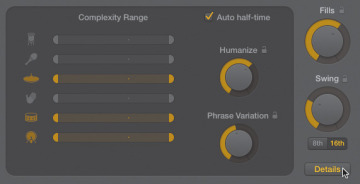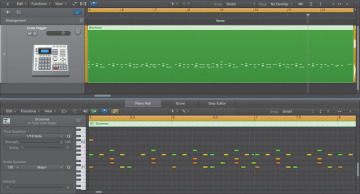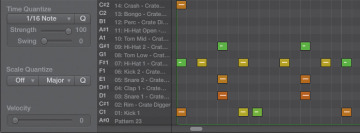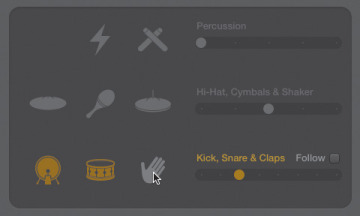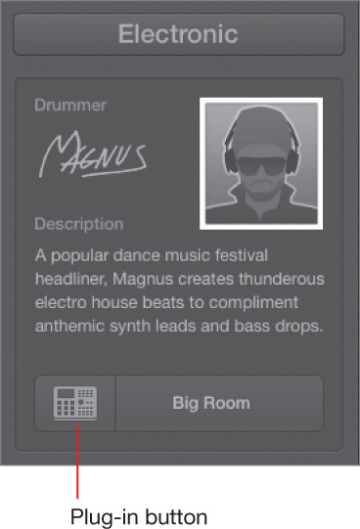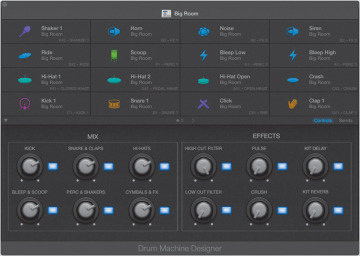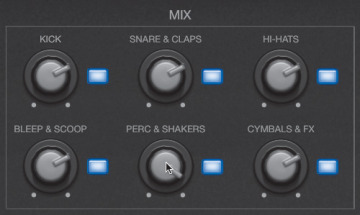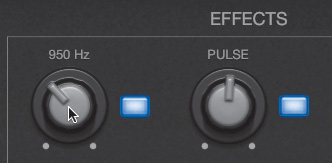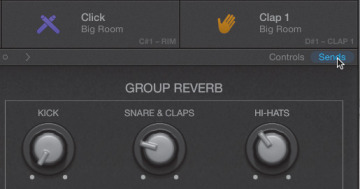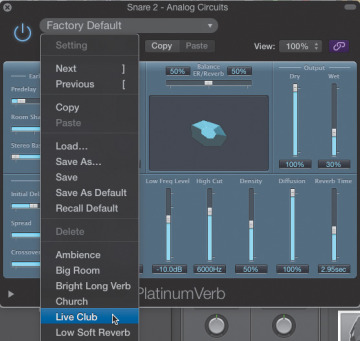- Creating a Drummer Track
- Arranging the Drum Track
- Customizing the Drum Kit
- Working with an Electronic Drummer
- Lesson Review
Working with an Electronic Drummer
When drum machines first made their appearance in recording studios, drummers feared for their careers. The eighties produced a number of hit songs in which live drummers were replaced by electronic drums programmed by music producers.
However, many producers quickly realized that to program exciting electronic drum beats, they needed to develop the chops of a real drummer, while others simply chose to hire drummers for this task. In Logic, you can use Drummer to create virtual drum machine performances, turning beat creation into a fast and fun exercise.
Creating Hip Hop Beats
In this exercise, you will work with one of the Hip Hop drummers, adjusting its feel to control the human quality in the timing, and later you’ll convert the Drummer region to a MIDI region to exercise complete control over each individual drum hit.
- In the Drummer Editor, from the Genre pop-up menu, choose Hip Hop.
Select the last drummer, Maurice.
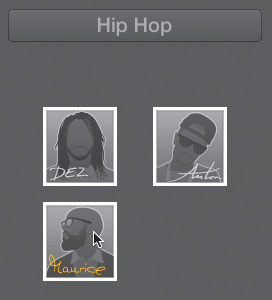
In the inspector, the Drum Kit Designer plug-in is replaced by Drum Machine Designer. The Drummer Editor updates to display drum machine samples. On the track, all the Drummer regions are refreshed to reflect Maurice’s playing style.
Listen to a few sections.
Maurice plays a very loose, swung hip-hop groove. Your project tempo is still set to 142 bpm, but the drummer plays half time, so it sounds like 71 bpm. Let’s work with the verse.
Drag the first Verse Arrangement marker to the ruler.
Cycle mode is on, and the cycle area corresponds to the Verse marker.
- Select the Drummer region below the cycle area, and press Z to zoom in.
In the Drummer Editor, click the Details button.
When the “Auto half-time” checkbox is selected, the drummer automatically switches to half time when the project tempo is 110 bpm or faster; those fast tempos are rarely used in hip-hop.
Deselect “Auto half-time.”
The drummer now plays at 142 bpm, which is much too fast for hip-hop.
In the LCD display, set the tempo to 87 bpm.
Maurice plays a very loose, almost sloppy beat. Let’s tighten the performance.
Turn the Humanize knob all the way down.
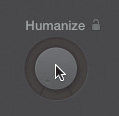
The groove is now machine tight.
Turn the Swing knob up to 66%.

The drummer swings a little more, making the beat bouncier. Except for the fills at the end of the fourth and eighth bars in the region, it keeps repeating a fairly similar pattern. Let’s make it vary the pattern a little more.
Turn the Phrase Variation knob all the way up.
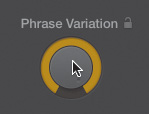
Now the beat is slightly different in every bar.
Let’s get rid of the crash cymbal on the first downbeat. Since the Drummer Editor doesn’t give you complete control over every single drum hit, you need to convert the Drummer region to a MIDI region.
In the workspace, Control-click the selected Drummer region and choose Convert to MIDI Region.
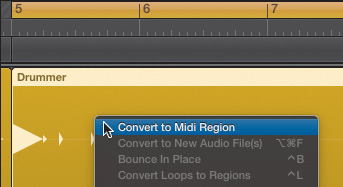
The yellow Drummer region is replaced by a green MIDI region that plays the same performance. The Drummer Editor is replaced by the Piano Roll Editor.
In the Piano Roll, the notes are represented by beams on a grid. The beams are positioned across a vertical piano keyboard that shows the MIDI note pitches. However, when working with drums, MIDI note pitches do not help identify the sound of the drums represented by each beam.
In the Piano Roll, choose View > Drum Names.
The vertical piano keyboard disappears, and the names of the drums are displayed in front of the grid.
On the downbeat of bar 5, click the note representing the Crash cymbal.
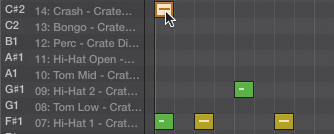
Press Delete to delete the selected note.
The crash cymbal is no longer triggered at the beginning of the verse.
You have replaced the acoustic drummer with an electronic drummer, adjusted the number of variations he plays, and made his playing sound tighter. Finally, you converted a Drummer region to a MIDI region to delete a single crash cymbal. In the next exercise, you’ll explore the remaining parameters of the electronic Drummer Editor.
Creating an Electro-House Track
When working with Drum Machine Designer, the Drummer Editor allows you to restrict the complexity range of individual samples, making it possible to have, for example, a simple kick and snare beat while another sample follows a more complex pattern.
You will now switch drummers to create an electro-house drum track, and you’ll create a ubiquitous four-on-the-floor kick and snare beat with a complex shaker pattern.
On the Drummer track, Control-click the MIDI region and choose Convert to Drummer Region.
In the Drummer region, the crash at the beginning of the region reappears: When you convert a MIDI region to a Drummer region, the region reverts to the Drummer performance you had before converting the region to MIDI.
- In the Drummer Editor, from the Genre pop-up menu, choose Electronic.
Select the first drummer, Magnus.

- In the control bar, change the tempo to 132.
Listen to the verse.
You hear a rather straightforward dance groove. You will first work on the kick and snare beat.
In the Drummer Editor, click the Details button to go back to the basic view; and mute the shaker, hi-hat, and handclaps.
Only the kick and snare are playing. On the upper line in the Drummer region, a secondary kick plays every bar. Let’s get rid of it.
In the XY pad, drag the puck to the left until the secondary kick disappears.
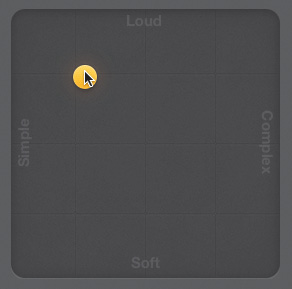
Now the snare may no longer play on beats 2 and 4 of every bar. You can fix that by adjusting its complexity range.
In the Drummer Editor, click the Details button.
You can drag the Complexity Range sliders for each individual drum piece to offset the complexity set by the puck in the XY pad.
Drag the snare’s left Complexity Range slider toward the right until you hear the snare play on beats 2 and 4 of every bar.

Let’s add a shaker to the party.
Click the shaker to unmute it.
The shaker plays a sixteenth note pattern, and it drops for a whole beat on beat 3 of bars 5, 7, 9, and 11. You are looking for a more consistent shaker groove.
Drag the shaker’s left Complexity Range slider all the way to the right.
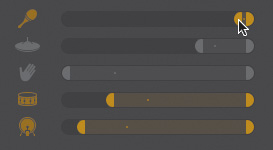
The shaker now plays the same sixteenth note pattern throughout the region.
After exploring the Complexity Range sliders, you now have a solid understanding of all the parameters in the Drummer Editor used by electronic drummers. It’s now time to move on to the drum machine itself so you can customize the drum sounds.
Customizing the Drum Machine Sounds
Now that you’re happy with the drummer performance, you can open Drum Machine Designer to adjust the mix, change the snare sample, tune it, and add some reverb.
At the bottom of the character card, click the Plug-in button.
The Drum Machine Designer interface opens.
The Drum Machine Designer interface consists of two parts:
Drums cells (at the top) to select and trigger individual drum samples.
Smart Controls (at the bottom) to adjust various parameters.
In the Mix section, turn up the Perc & Shakers knob.
The shaker sounds a little louder.
In the Effects section, try turning up the Pulse and turning down the High Cut Filter.
The Pulse knob controls a pulsating filter that affects the shaker pattern, whereas the High Cut Filter knob muffles the entire kit.
Click the buttons next to the Pulse and High Cut Filter knobs.
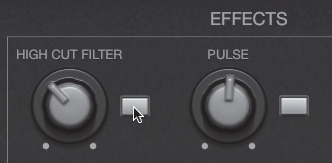
Both effects are turned off, and you can hear the full frequency range of the drum sounds.
At the upper right of the Smart Controls, click the Sends button.
The Smart Controls display knobs that control the amount of delay and reverb for different drum kit elements.
In the Group Reverb section, turn Snare & Claps all the way up.
You can hear a short reverb added to the snare; however, that’s not the type of reverb sound you’re after. You will later find a more suitable reverb for this snare, so let’s turn that one down.
Turn Snare & Claps all the way down.
You will now swap the kit piece patch for the Snare.
Click the Snare 1 cell.
The Snare 1 cell is selected, and the Smart Controls update to display knobs affecting that cell.
In the Snare 1 cell, click the S button.

The snare is soloed.
- Open the Library.
Choose Snare 2 – Analog Circuits.

In Drum Machine Designer, the cell displays the new patch name.
- In the Smart Controls, turn the Pitch knob down to A2.
Turn the Length knob down to shorten the snare sound.
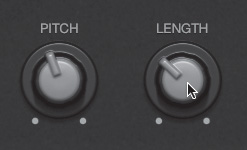
In the inspector, the right channel strip controls the sound of the selected cell in Drum Machine Designer. Let’s add the desired reverb to the snare.
- On the right channel strip in the inspector, click the first empty Audio FX insert in the Snare 2 cell, and choose Reverb > PlatinumVerb.
In the PlatinumVerb window, from the Settings menu, choose Live Club.
In PlatinumVerb, drag the Wet slider up to increase the amount of reverb.
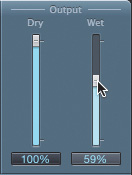
- In Drum Machine Designer, click the S button in the Snare 2 cell to turn solo off.
You have adjusted the kit mix, played with some main effects, swapped one of the drum samples, adjusted its sound, and added a plug-in to its channel strip to get the sound you wanted.
You have produced drums for a whole song, and you’ve learned many ways to edit the drummer’s performance and change the feel. You also customized drum kits to get your desired sound. With Drummer, Drum Kit Designer, and Drum Machine Designer, Logic Pro X allows you to quickly lay down a rhythmic foundation for a wide range of modern music genres.
